1950s: An American Dream?
Many have a nostalgic view of the 1950s. On the surface, this decade beamed with prosperity with new homes, automobiles and appliances. Yet, under this decade’s shiny appearance, many felt pressure to conform to societal norms.
The American dream of the 1950s centered on nuclear families living in modern, suburban homes. However, not all was ideal. Family roles were changing. The business industry used color to target consumer behaviors. Everything from leisure activities to automobiles to appliances pushed for sameness and for keeping up with ones neighbors. The countryside itself shifted as new highways were built. Changes were brewing below the surface of the American dream.
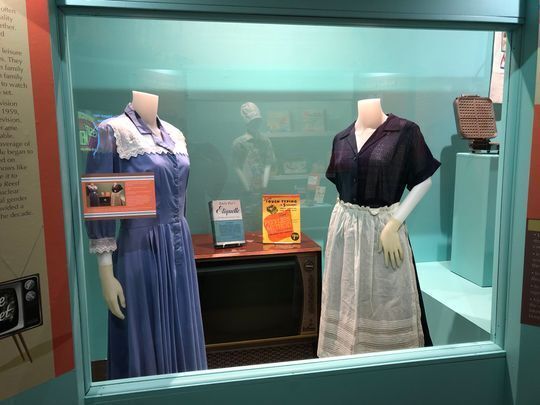
Family Time
Families often spent quality time together. The word “family” stressed leisure activities. They dined in family restaurants and took family vacations in family cars. They gathered in the family room to watch family programming on their television set.
From 1948 to 1950, the United States saw a surge in television set sales from 7,000 to 5 million. By 1959, 90% of homes had a television. Color televisions also became both popular and affordable. Audiences viewed an average of six hours per day. People began to accept what they viewed on television as normal. Shows like Ozzie & Harriett, Leave it to Beaver, and The Donna Reed Show depicted ideal nuclear families with traditional gender roles. This content provided a rose-colored glasses view of the decade.
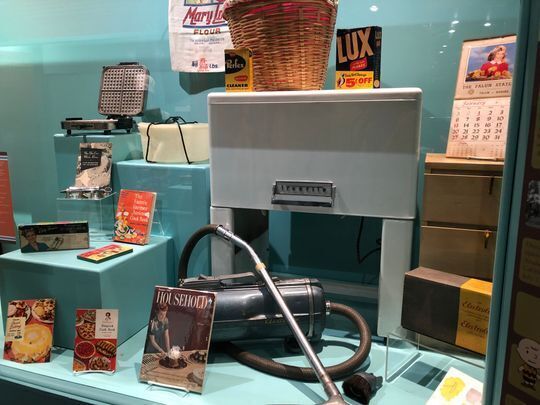
The Ideal Housewife & The Feminine Mystique
After American servicemen returned home from WWII, many women lost their jobs and returned to homemaking duties. Societal norms said women should manage the household and care for children.
Feminine images shown by media shaped the stereotypical housewife. Many women embraced this image. Others rebelled. Many sought jobs to raise their status and to eliminate the boredom of suburban living.
In 1957, Betty Friedan attended a class reunion at Smith College and surveyed former classmates. She discovered women were dissatisfied with their lives. They felt the media’s image of women was inaccurate. While these women were educated, many felt displaced from society. They felt stuck in the role as a housewife. This prompted Friedan to write the book, Feminine Mystique (1963) that challenged the traditional homemaker’s role and prompted change for women’s rights.
Friedan criticized Dr. Benjamin Spock’s guidance on the mother’s role in the home. Friedan’s book prompted a review of the ideas on traditional gender roles in the 1950s. The term, “feminine mystique” described the cultural acceptance and erroneous ideal of the housewife. It dispelled the myths that were at the core.
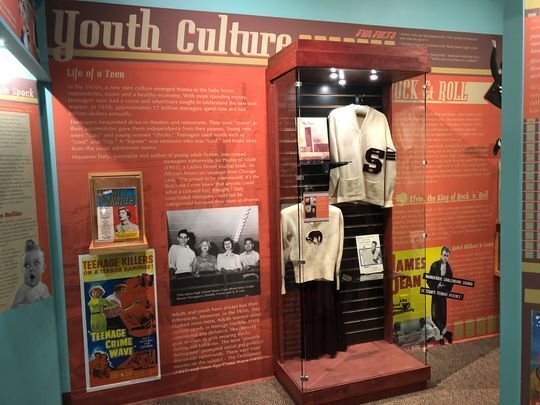
Life of a Teen
In the 1950s, a new teen culture emerged thanks to the baby boom, automobiles, music and a healthy economy. Teenagers now had a voice and advertisers sought to understand the new teen market. In 1958, approximately seventeen million teenagers spent nine and half billion dollars annually.
Teenagers frequented drive-in theaters and restaurants. They went “crusin” as their automobiles gave them independence from their parents. Young men were “cats” and young women, “chicks.” Teenagers used words such as “cool” and “hip” A “hipster” was someone who was “cool,” and broke away from the usual adolescent norms.
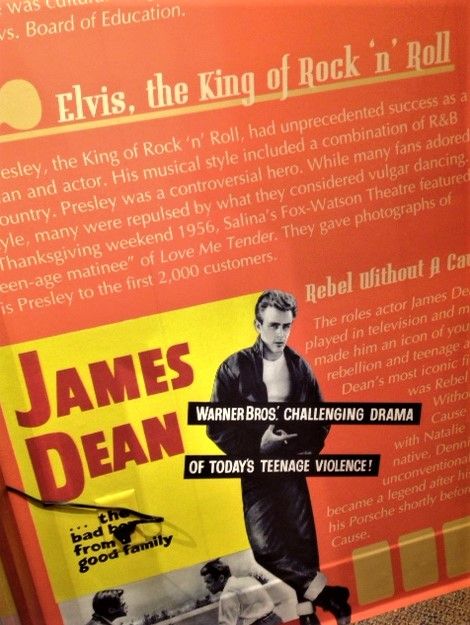
Delinquency & Rock 'n Roll
Adults and youth have always had their differences. However, in the 1950s, they clashed even more. Adults worried about current trends in teenage lifestyle. Many considered any defiance, like chewing gum in class or girls wearing slacks, delinquent behavior. The term “juvenile delinquent” prompted social and political discussion nationwide. There were even movies on the subject – The Delinquents (1957) and Teen-Age Crime Wave (1955).
Rock and roll’s roots were in rhythm and blues, music historically linked to African American musicians. This terrified some white middle-class adults. For teenagers, the “relentless rhythm” of the music was great for dancing and became incredibly popular. Television shows like American Bandstand (1952-1989) with host Dick Clark helped to promote music and dancing.
Elvis Presley, the King of Rock and Roll, had unprecedented success as a musician and actor. His musical style included a combination of R&B and country. Presley was a controversial hero. While many fans adored his style, many were repulsed by what they considered vulgar dancing. On Thanksgiving weekend 1956, Salina’s Fox-Watson Theatre featured a “teen-age matinee” of Love Me Tender. They gave photographs of Elvis Presley to the first 2,000 customers.
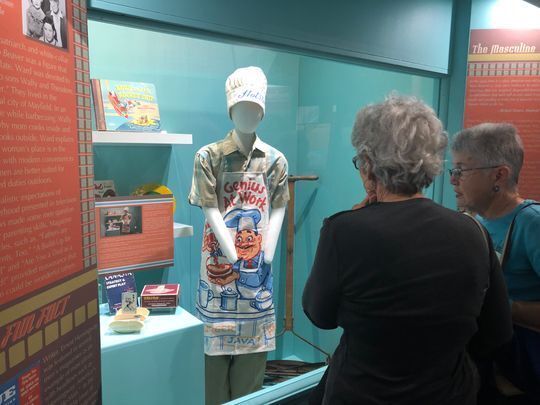
The Masculine Provider
Post World War II society expected men to be the sole provider for their families. Yet, changing norms encouraged men to be more involved with household activities like parenting, but from a distance. These confusing messages reflected the era’s struggles with conformity and urbanism.
Meanwhile, men chased the American Dream as loyal employees in a growing workforce. Fiction novels, such as Organization Man and The Man in the Gray Flannel Suit, featured men who conformed to a group work ethic, rather than individual expression. Some men found it difficult to balance the expectations of loyalty to work and devotion to family.
Unrealistic expectations of fatherhood presented in television shows made some men question their parenting skills. Magazine articles, such as, “Father’s are Parents, Too,” “A Build-Up for Dad,” “Are You a Dud as a Dad?” provided reassurance that men could be wonderful fathers.
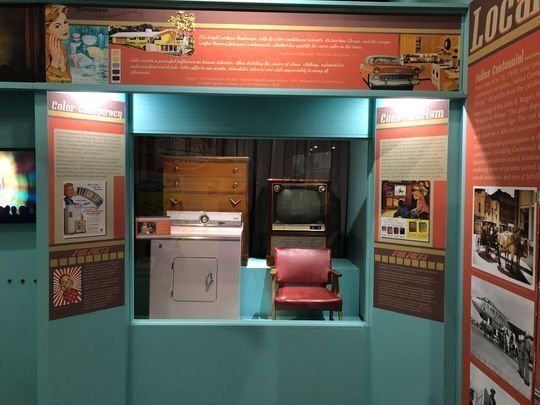
Consumerism & Color Conspiracy
After World War II, new technologies, more products, and a booming economy, led to increased consumer spending. During the war years, manufacturers put all efforts into war production. So, when large ticket items such as automobiles and appliances became available, consumers snatched them up. The average consumer saved less and spent more. Consumerism was fueled by the idea technology advances would make some things obsolete. This helped foster the “Keeping up with the Joneses” attitude that persists in American society.
In 1952, Business Week ran an article titled, “Picking the Color That Sells.” Marketers exploited the power of color to influence consumers. Color was key in product design, packaging, and advertising. With the use of color, everyday products, such as kitchen appliances, became fashion accessories. Commercials by Westinghouse influenced customer spending in the 1950s. They used actors, such as Betty Furness, to successfully convince viewers to buy products based on want, not need.
Salina Centennial
From May 4-10, 1958, civic pride and community spirit marked the centennial anniversary of Salina. Salina Centennial, Inc. dubbed the celebration “Wagons to Wings.” All profits from the celebration funded revitalization at Indian Rock Park.
Sam Grogg of the John B. Rogers Producing Company of Ohio produced a play, “Wagons to Wings.” The play depicted Salina’s growth – a story from its early years to the Atomic Age. The cast included over 750 local citizens. The play took place on a 300 ft panoramic stage with special lighting and music effects.
Community wide participation in this event took place. There were several committees, including Centennial Belles and Brothers of the Brush. Downtown business owners decorated windows with the “Wagons to Wings” theme. A weeklong series of parades turned out an estimate of 50,000 people and included a parade downtown and one at Schilling Air Force Base.
Thank You Sponsors!
Debbie and John Divine
Larry and Joy Smith
Bette Timmel




























